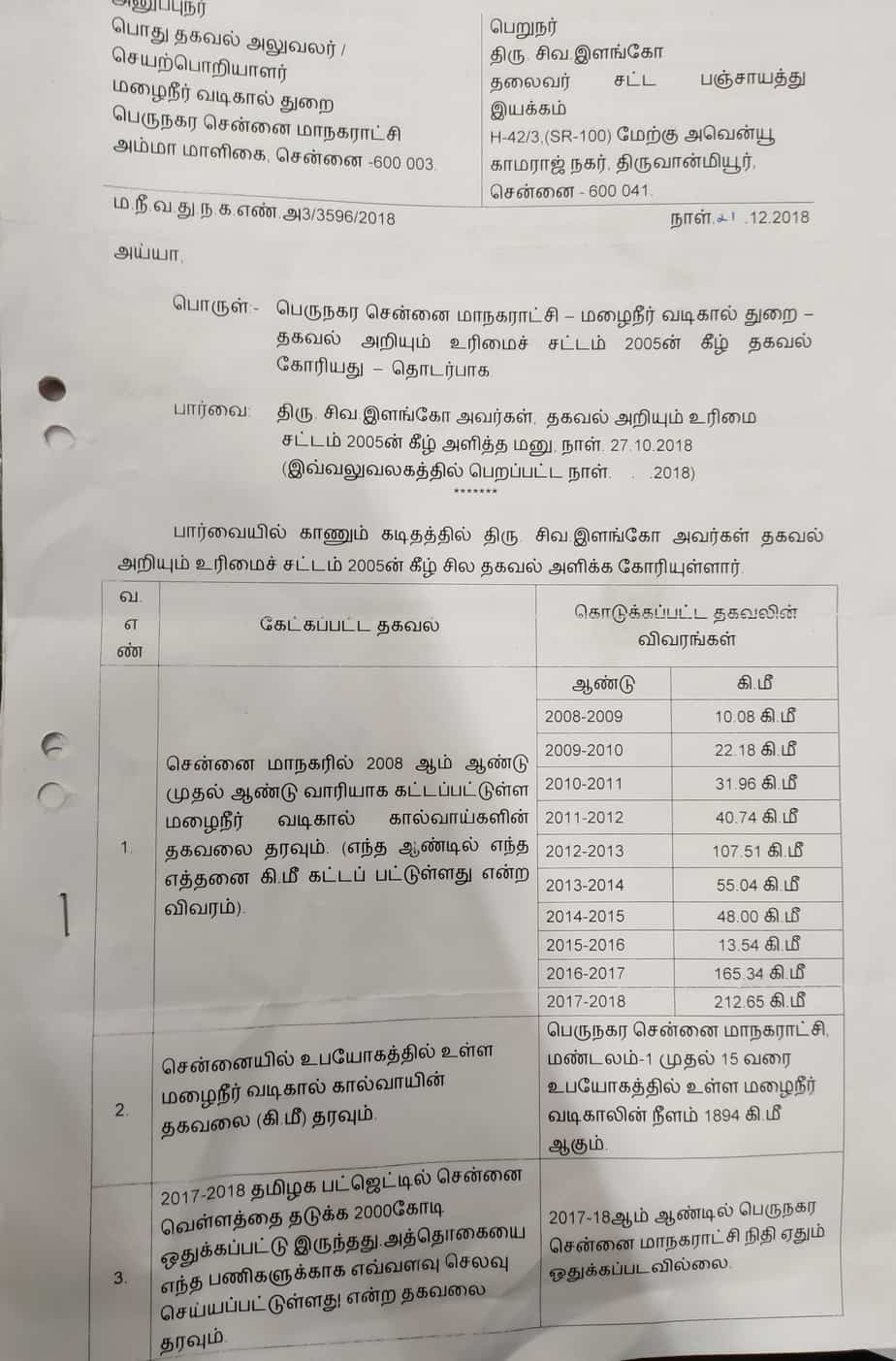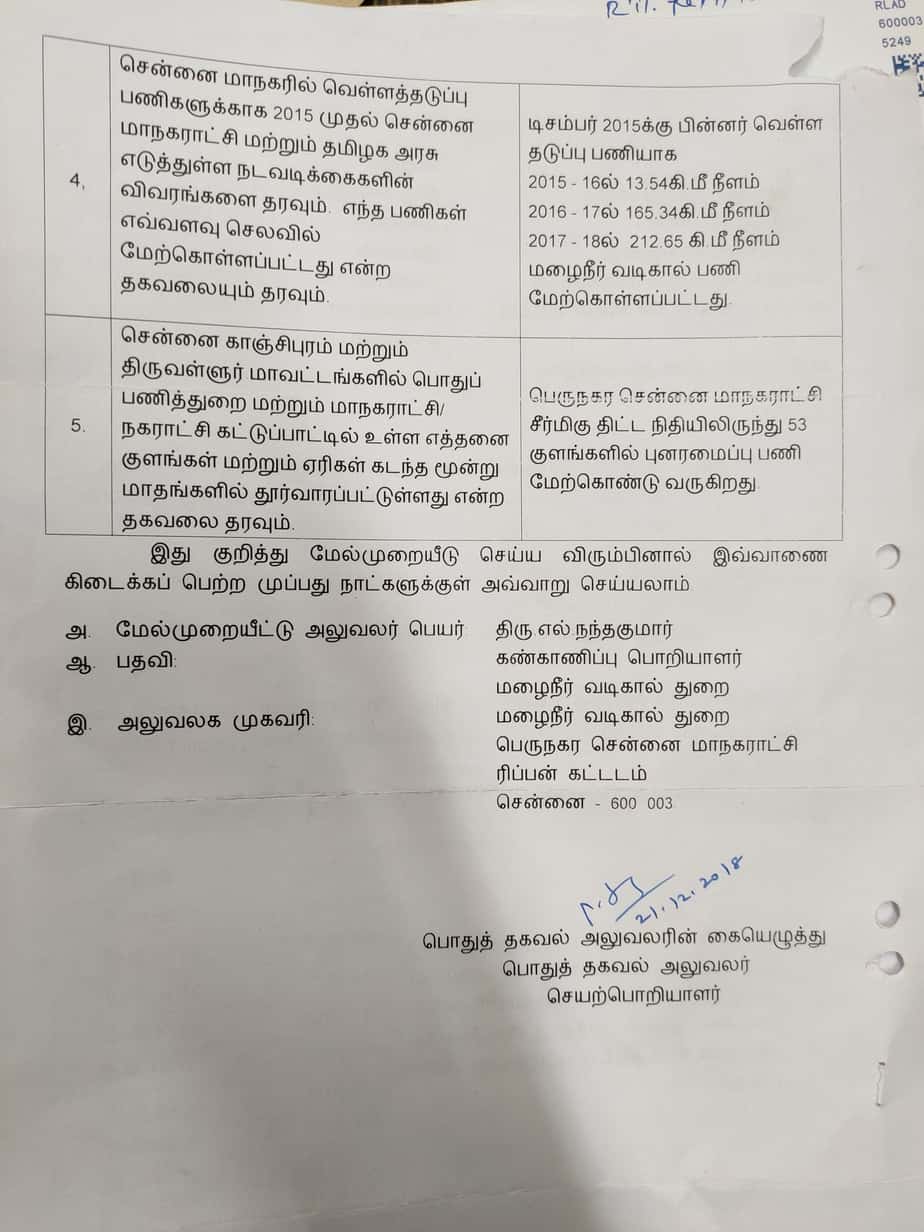Are you a Chennaiite negotiating the busy roads of the city almost daily? Have you noticed the sidewalks being dug up on your way to Anna library or EA Mall or Chennai Central in recent times? Did you wonder why these roads are being dug up all of a sudden throughout the city?
Of floods and droughts
Chennai has seen the worst of nature’s fury several times in the recent past, with the frequency of floods and droughts having increased drastically. Post the historic floods in 2015, Cyclone Vardah devastated the city once again in 2016. However, as the monsoon had a very poor show in 2016, Chennai witnessed a drought in 2017 that had been unprecedented in the last 140 years.
Though the northeast monsoon was good in 2017, a heavy spell over two days in November 2017 caused a scare and brought back memories of the floods of 2015. Poor northeast monsoons in 2018 left Chennai reeling under severe drought in 2019 and the city’s major reservoirs that supply water — Chembarambakkam, Poondi, Red hills and Cholavaram — ran dry. National and global media were rife with reports of a Cape Town like crisis in Chennai.
In modern cities, well-networked storm water drains are a critical component to prevent flooding in cities. Chennai has 5500 – 6000 Km of roads and it’s highly important for all these roads to have SWDs, which in turn should be connected to bigger water bodies such as lakes, ponds and rivers in the city.
However, it has come to light that Chennai is woefully short of Storm Water Drains (SWD), which are essential for draining and harvesting rainwater.
Alarming numbers
Satta Panchayat Iyakkam (SPI), an NGO headquartered in Chennai, filed a number of RTIs with Chennai corporation as part of a study on the city’s storm water drain network. The responses reveal a deep problem in the city. The reply to the RTI stated that only 1894 KM out of the total 5500Km of roads in the city are networked with storm water drains as of October 2018.
This means that only 34% of the Chennai roads have the capacity to drain the rainwater that roads collect. The most shocking information was that Chennai Corporation built only 326 KM of SWDs over a span of 7 years (2008-2009 to 2015-2016).

The RTI revealed gaps in disaster preparedness, with no flood mitigation expenditure. Pic: Ranga Prasad/SPI

RTI received by Sattapanchyat Iyakkam shows details of the slow pace of progress until before the floods. Pic: Ranga Prasad/SPI
To add to this, the limits of the Chennai Corporation have rapidly expanded in the last 15 years. In October 2011, the area within Chennai’s boundaries was increased from 176 square kilometre to 426 square kilometre and 45 wards were newly introduced. But the civic body has failed to cope with such pace of development. Though new taxes are levied on these areas, people do not have the most basic facilities that the local government must ensure. Among the crucial amenities missing are storm water drains. Despite repeated requests by citizens over the last eight years, even initial works for laying storm water drains are yet to begin.
In recent years, the Corporation, which learnt a big lesson after the 2015 floods, has stepped up its efforts towards expanding the SWD network. The civic body which built only 326 km of SWDs in the 7-year span till 2016, constructed 377 km of SWDs over just two years (2016-17 and 2017-18), according to the RTI data. However, this 377 km is included in the 1894 km of total SWD coverage, which is not even 50% of what Chennai requires.
Another revelation of note in the RTI is that the Chennai Corporations admits to have failed in carrying out any flood management mitigation work, other than constructing SWDs post the 2015 floods.
Water woes
Chennai city, which shares its zones with Kanchipuram, Tiruvallur and Chennai districts, has a huge number of lakes, ponds and marshlands. Most of these water bodies are encroached, have shrunk in size, or lack water that is fit for consumption and usage. As the connectivity of the existing SWDs with these water structures are poor, flooding occurs in lived-in localities, whereas the water bodies do not get recharged.
With an annual average of 1400-1500 mm rainfall, Chennai is one of the wettest places in Tamil Nadu. Ironically, the city suffers severe drought only because rain water is not harvested efficiently. In simple words, absence of SWDs results in both floods and drought for Chennai.
In addition to these woes with respect to SWDs, many residents let their raw sewage into water bodies directly due to a number of issues with their underground sewage system. This severely pollutes the water and the natural water bodies. The authorities have so far failed to take concrete action against such polluters.
Scams in the making
A number of scams related to SWDs have also been unearthed in the past few years by the Comptroller and Auditor General as well as NGOs like Arappor Iyakkam. Execution of storm water drains without topographical, meteorological and hydrological study and without ultimate linkage to natural water bodies has resulted in construction of drains with inadequate size, which would ultimately result in inundation of roads, says a damning CAG report released in 2017.
Out of the 54 new drains that were constructed by the corporation, 51 were found to be faulty and had to be reconstructed at a cost of Rs 54 crore. The initial cost of construction of these drains stood at Rs 21 crore. The negligence of authorities has consumed Rs 75 crores of taxpayers money.
Arappor Iyakkam also exposed various discrepancies in construction of SWDs last year. For no reason, existing drains were demolished and constructed by corporation as revealed by an RTI. Post this expose, Chennai Corporation assured that those drains wouldn’t be demolished and cancelled few tenders.
Planning, implementation, construction, enforcement, maintenance – Chennai Corporation has failed in all these categories when it comes to SWDs. Chennai will have to face the cycle of floods and drought till these SWDs are constructed and connected with lakes, ponds and marshlands which in turn are connected with rivers that ultimately meet the Bay of Bengal. It’s imperative that Chennai Corporation and Public Works Department understand the importance of this water chain.
This issue will be complet only aftwr 100 years because all works are very slow and there is competition between dept to damage road every road. No proper inspection or supervision by authorities for ensure quality etc. Need strickt rule for bring rule for give guarantee for minimum 5 years and strickt law against damaging roads. Need to replace old type of drainage system to maintain road and city neat and clean.